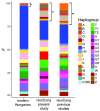Correction: Mitogenomic data indicate admixture components of Central-Inner Asian and Srubnaya origin in the conquering Hungarians
- PMID: 30496271
- PMCID: PMC6264144
- DOI: 10.1371/journal.pone.0208295
Correction: Mitogenomic data indicate admixture components of Central-Inner Asian and Srubnaya origin in the conquering Hungarians
Abstract
[This corrects the article DOI: 10.1371/journal.pone.0205920.].
Figures





Erratum for
-
Mitogenomic data indicate admixture components of Central-Inner Asian and Srubnaya origin in the conquering Hungarians.PLoS One. 2018 Oct 18;13(10):e0205920. doi: 10.1371/journal.pone.0205920. eCollection 2018. PLoS One. 2018. PMID: 30335830 Free PMC article.
References
Publication types
LinkOut - more resources
Full Text Sources

